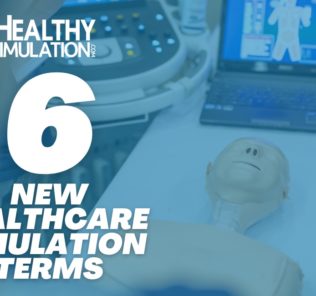How AR Technology Represents the Future of Healthcare Simulation Training
The use of augmented reality simulation is increasing across clinical simulation learning environments as the technology provides unique opportunities for immersive reality. Medical simulation company MedCognition is currently using AR in simulation and devices to reshape the future of healthcare training by making the experience look and sound more human. MedCognition developed a holographic patient simulation called PerSim, which is short for “person simulation.” The company’s goal is to provide AR technology training that is ultra-portable, clinically intuitive and easy to use. The mission is to help frontline clinicians save more lives.
To achieve this goal, MedCognition is pushing AR’s boundaries by utilizing industrial-grade heads-up display hardware such as the Microsoft HoloLens, making on-demand real-time patient simulation available almost anywhere. Use of such hardware is incorporated into the company’s product design to render medically intuitive holographic patient presentations into any clinical environment where medical simulation training is needed.
According to MedCognition’s chief medical officer, Hector Caraballo, MD, the future of safety in healthcare lies primarily in expanding medical simulation beyond the confines of sim labs, classrooms and computer monitors. By offering healthcare simulation experiences with added dimension, learners receive a more comprehensive training experience that better prepares them for real-world scenarios.
Sponsored Content:
“In other words, [the future of healthcare safety lies in] in situ medical simulation. The simultaneous challenge of improving decision making and improving actual clinical workplaces is the next level of medical simulation,” Caraballo explains. “The only way to learn the limits of a clinical environment is through experience. No technological advancement is better poised to address this than augmented reality.”
With PerSim, clinicians can practice caring for critically ill patients in the classroom or wherever the actual lifesaving care is provided. These environments can include an incident site, the back of an ambulance, an emergency room or an operating room. Learners can stream PerSim easily for online and remote simulation sessions.
Each holographic patient clinical simulation is instructor-led, and cases can change in real-time at the tap of a finger. PerSim replicates complex disease conditions that are otherwise impossible to create in real time and on demand with mannequins, other AR systems or even VR systems. For example, in respiratory distress simulations, the healthcare simulator slowly increases respiratory rate and engages accessory muscles in a realistic way to demonstrate increased effort to breathe, and the instructor can modify the sim patient condition based on the trainee’s management choices.
The PerSim system itself, weighing about 35 pounds, is so transportable that the solution can be checked in as luggage on flights. Without the highly protective case, all the components fit into a backpack for even more convenience. According to MedCognition, PerSim is easy to use and can be deployed in under an hour for beginners. For those with more experience, the technology can be deployed in just minutes.
Sponsored Content:
Further, the base system uses specialty hardware and custom-developed software created by clinicians, simulation educators and computer scientists. The hardware included in the system is the Microsoft HoloLens — a durable, comfortable device designed for hours-long use — two tablets, a portable wireless router and a durable carrying case. In addition, the software in the system consists of the PerSim instructor and PerSim monitor.
“PerSim is transforming medical simulation. There will be less of the tell-don’t-see-and-imagine-doing traditional healthcare simulation model and more of a streamlined see-think-do-reassess clinically intuitive model. Nothing beats the experience of taking care of actual patients, but we aim to get as close as possible,” Dr. Caraballo said.
“The goal, in the end, is not a technology goal. We want the technology to create and shape the clinical mind as early in healthcare training as possible,” Caraballo said. “Ideally, once you get PerSim up and going, the technology is quickly forgotten. The trainee instead finds themselves immersed in the complexities of patient assessment and clinical decision-making.”
More about MedCognition
Founded in 2016, MedCognition is a Texas-based medical simulation education training company developed by emergency medicine clinicians, educators and computer scientists through a partnership with University of Texas Health San Antonio and the University of Texas at San Antonio. The mission of MedCognition is to help front line healthcare workers reduce medical errors and save more lives by providing realistic medical simulation both in the classroom and in the clinical workspace.
The company’s AR training platform, PerSim, is the first-of-its-kind patient simulator specifically designed to help medical providers enhance critical thinking and mitigate potential mistakes. By leveraging the latest in AR and holographic technology, PerSim represents a leap forward in realism, portability and affordability, allowing medical professionals to train for those critical times when being their best saves more lives. The company’s founders include a nationally known speaker on cognitive errors in emergency medicine, nationally recognized emergency medicine educators, U.S. Army combat veterans, and an internationally recognized expert in AR technology.
Learn More About MedCognition
Lance Baily, BA, EMT-B, is the Founder / CEO of HealthySimulation.com, which he started in 2010 while serving as the Director of the Nevada System of Higher Education’s Clinical Simulation Center of Las Vegas. Lance also founded SimGHOSTS.org, the world’s only non-profit organization dedicated to supporting professionals operating healthcare simulation technologies. His co-edited Book: “Comprehensive Healthcare Simulation: Operations, Technology, and Innovative Practice” is cited as a key source for professional certification in the industry. Lance’s background also includes serving as a Simulation Technology Specialist for the LA Community College District, EMS fire fighting, Hollywood movie production, rescue diving, and global travel. He and his wife live with their two brilliant daughters and one crazy dachshund in Las Vegas, Nevada.
Sponsored Content:

















